
 Data Structure
Data Structure Networking
Networking RDBMS
RDBMS Operating System
Operating System Java
Java MS Excel
MS Excel iOS
iOS HTML
HTML CSS
CSS Android
Android Python
Python C Programming
C Programming C++
C++ C#
C# MongoDB
MongoDB MySQL
MySQL Javascript
Javascript PHP
PHP
- Selected Reading
- UPSC IAS Exams Notes
- Developer's Best Practices
- Questions and Answers
- Effective Resume Writing
- HR Interview Questions
- Computer Glossary
- Who is Who
How to Draw the Solar System?
The Sun is at the center of our Solar System and around it revolve eight planets and several moons. The eight planets in the increasing order of their distance from the Sun are Mercury, Venus, Earth, Mars, Jupiter, Saturn, Uranus, and Neptune. Pluto was regarded as the ninth planet until 2006 after which the International Astronomical Union decided to downgrade it to a dwarf planet.
In this step-by-step guide, learn how you can draw a model diagram of Solar System. It is quite easy to draw the Solar System once you know the placement of the planets around the Sun.
Step 1: Start with the Sun at the Center
Since all the other objects of the Solar System revolve around the Sun, it is good to start with the Sun. Draw a big circle and paint it a mix of orange-red-yellow which will represent the Sun. If you are using a canvas, then make sure there is enough space left to draw the eight planets around the Sun.
While drawing the Sun, keep in mind that it is the largest celestial object in the Solar System and holds almost 99% of the entire mass. Its gravitational pull holds the planets and moons in their orbits. Hence, the Sun should have the most prominent and distinct appearance on your sketch.
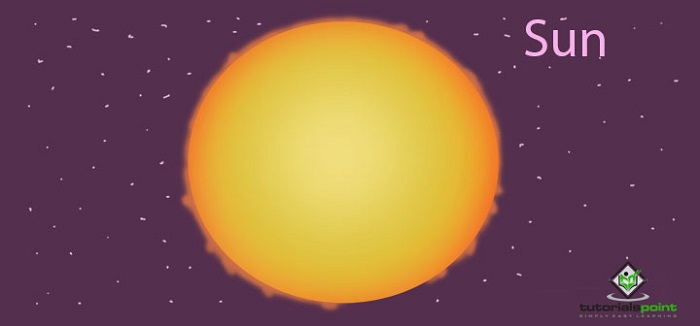
To add some effect and give it more importance, you can draw some pointed triangles around the Sun to depict the fact that it is a giant ball of gas that keeps burning its fuel using a process known as "nuclear fusion".
Step 2: Draw the First Planet around the Sun
Draw a slightly elliptical circle around the Sun (and not very far from it). This will represent the orbit of Mercury, the planet that is nearest to the sun. Then draw a small circle on this orbit and paint it metallic grey to depict the planet Mercury.
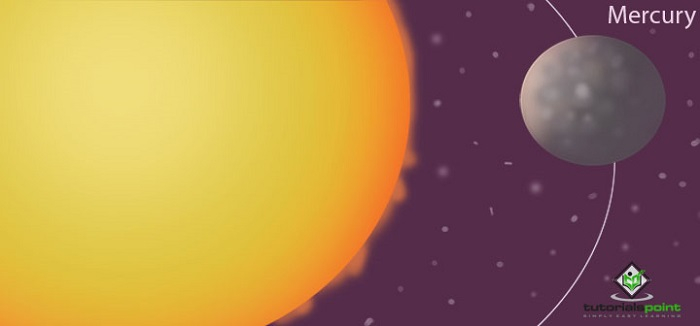
Mercury is the smallest planet of the Solar System. It has a very thin layer (almost negligible) of atmosphere, which is why it reflects back most of the sunlight and appears grey. The surface of Mercury has a similar appearance as our Moon.
Step 3: Next Comes Venus
Draw a slightly larger elliptical path (orbit) next to the orbit of Mercury. Draw an orange-yellow circle (bigger than the size of Mercury) on it to depict the planet, Venus. This second planet of the Solar System is almost the same size as Earth.
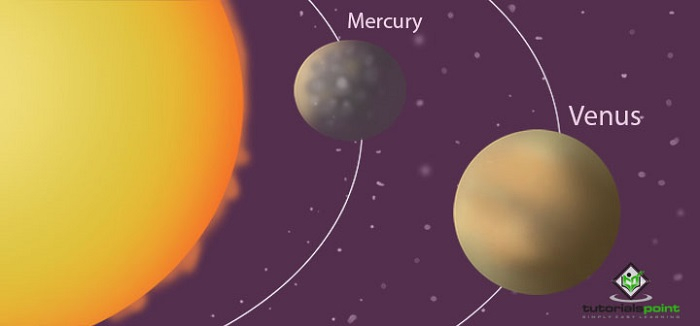
Contrary to Mercury, Venus has a thick and dense atmosphere that is full of toxic gases. It orbits the Sun in retrograde motion, which means the Sun rises on the Venus from the West and sets in the East.
Step 4: Draw Our Home Planet, the Earth
Earth is the third planet from the Sun and it is just slightly bigger in size than the Venus. To show the placement of the Earth, draw a larger ellipse next to the orbit of Venus, draw a circle on this elliptical path, and paint it blue. To make it a little more realistic, paint some patches of the Earth green, which will highlight the point that our planet has perfect mix of land, water, and atmospheric gases.
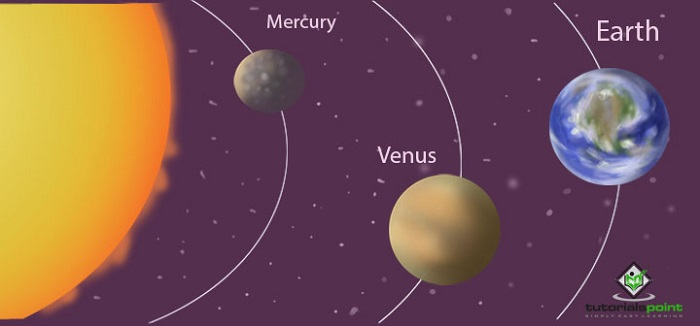
Earth is the largest and heaviest among the four inner rocky planets.
Step 5: Draw the Red Planet, the Mars
Mars is the fourth planet in the increasing order of distance from the Sun. To show the location of Mars, draw a bigger elliptical path next to the orbit of the Earth. On this elliptical path, draw a smaller circle and paint it red. The size of Mars is significantly smaller than the size of Earth.
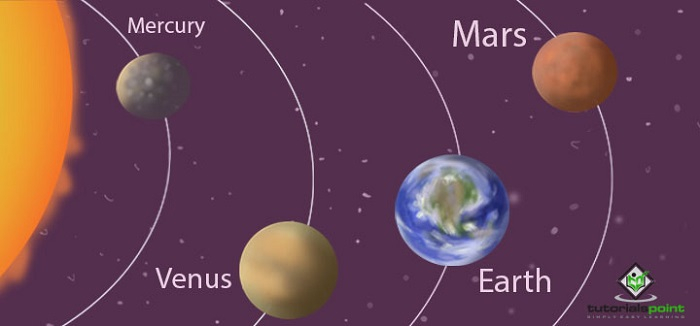
It is believed that Mars had water in the past but it couldn't hold onto its water due to its weaker gravitational pull. Solar winds blew the lighter particles away from its thin atmosphere and most of the oxygen reacted with the metals on its surface to form iron oxides. This is what gives Mars its prominent rustic-red color.
Step 6: Show the Placement of Jupiter
Draw a large elliptical path next to the orbit of Mars and draw a large circle on it to represent Jupiter. While drawing the circle for Jupiter, keep in mind that it is the largest planet and the next massive celestial object of the Solar System after the Sun.
Leave enough space in between the orbits of Mars and Jupiter. This is where we have the asteroid belt which is a collection of countless rocky objects of different sizes that can range from a few centimeters to even several miles. In this space, draw a set of small, uneven solid grey circles to show the asteroid belt.
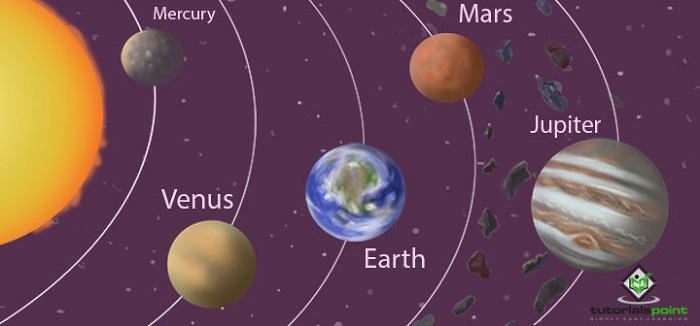
Draw three to four horizontal wavy bands inside Jupiter and color these bands with different shades of orange. Draw an ellipse inside on of these bands, color it "red", and draw swirling circles inside it to show the Great Red Spot of Jupiter, which is the prominent feature of Jupiter.
The Great Red Spot is a huge hurricane that is almost twice the size of Earth and quite miraculously, it has been there ever since Galileo saw it through his telescope.
Step 7: Draw the Planet Saturn, the Lord of the Rings
Saturn is by far the most picturesque planet of our Solar System. What sets it apart from other planets is its magnificent rings. To show the placement of Saturn, draw an elliptical path next to the orbit of Jupiter and on this path, draw a circle slightly smaller in size than Jupiter. Use a mix of grey and brown to paint Saturn and give its rings a distinct look by using a mix of grey and white.
The rings of Saturn have several identifiable bands and most of these rings contain ice particles of variable sizes that reflect most of the sunlight, which is why the rings look so spectacular.
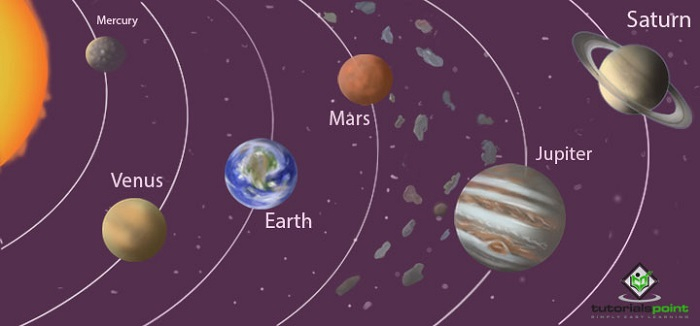
An interesting fact about Saturn is its low density. It is the only planet in our Solar System with a mean density less than that of water, which means if there was a giant pool of water that could fit the size of Saturn, then the planet would miraculously float on it!
Step 8: Draw Uranus Next to Saturn
Sketch the orbit of Uranus next to the orbit of Saturn. Use a mix of blue and green to color the surface of Uranus. Uranus is the seventh planet of the Solar System. It's one of the ice giants that is mainly composed of particles that are heavier than hydrogen and helium such as oxygen, Sulphur, nitrogen, etc.
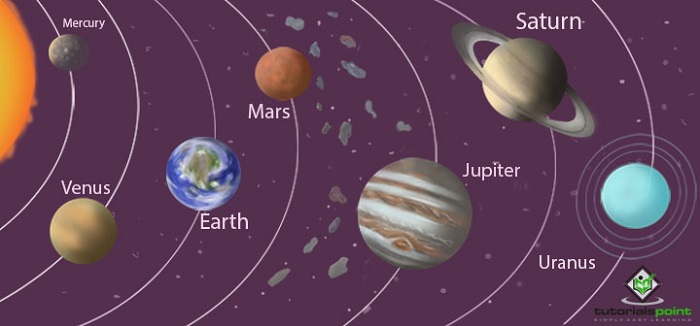
The most distinguishing feature of Uranus is its wild tilt of more than 90 degrees which is why its equator is almost perpendicular to its orbit. Just like Saturn, it has a set of rings but unlike the rings of Saturn, the rings of Uranus are not as prominent. Draw thin lines of rings around Uranus but in a vertical fashion which will also depict the unusual tilt of Uranus.
Step 9: Draw Neptune, the Eighth Planet of the Solar System
Neptune is also an ice giant which appears blue, just like our home planet. To depict Neptune, draw an elongated elliptical path next to the orbit of Uranus and draw a solid blue circle on the orbit. Neptune is slightly smaller in diameter than its neighbor Uranus, but interestingly, it's heavier than Uranus.
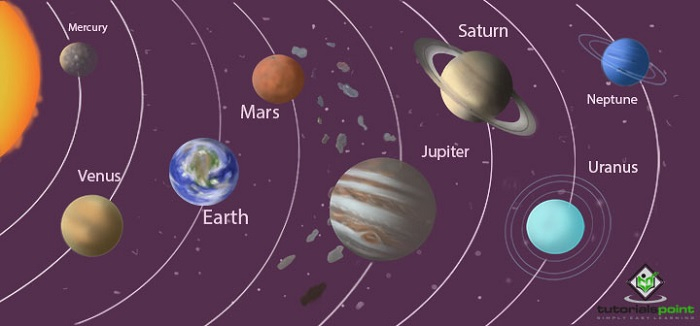
Neptune too has a thin set of rings, but they are not as prominent. Neptune is so distant from the Sun that it takes an incredible 165 years to complete one orbit around the Sun.
Next to the orbit of Neptune, you can draw an elliptical band of uneven objects to show the Kuiper Belt, which is similar to the Asteroid Belt but almost 20 times wider. However, it is optional and completely up to you whether you want to show the Kuiper Belt or not. Draw the Kuiper Belt at the edge of your canvas to show the periphery of the Solar System.
Conclusion
Apart from the Sun and the Planets, our Solar System contains several prominent moons, but it's not easy to show them all on a small canvas. For example, Ganymede is one of the moons of Jupiter and its radius is bigger than Mercury and Pluto. Europa is another fascinating moon of all the 80 known moons of Jupiter. Similarly, Titan is the largest moon of Saturn and what is special about Titan is its dense atmosphere and the presence of stable liquid form on its surface. How can we forget our very own Moon, which is almost one-fourth of its parent planet. It's unusual for any planet to have such a large moon and scientists believe that it's the gravitational pull of our Moon that stabilizes the tilt of Earth due to which we have a stable weather pattern that allowed life to originate and flourish on the Earth.

